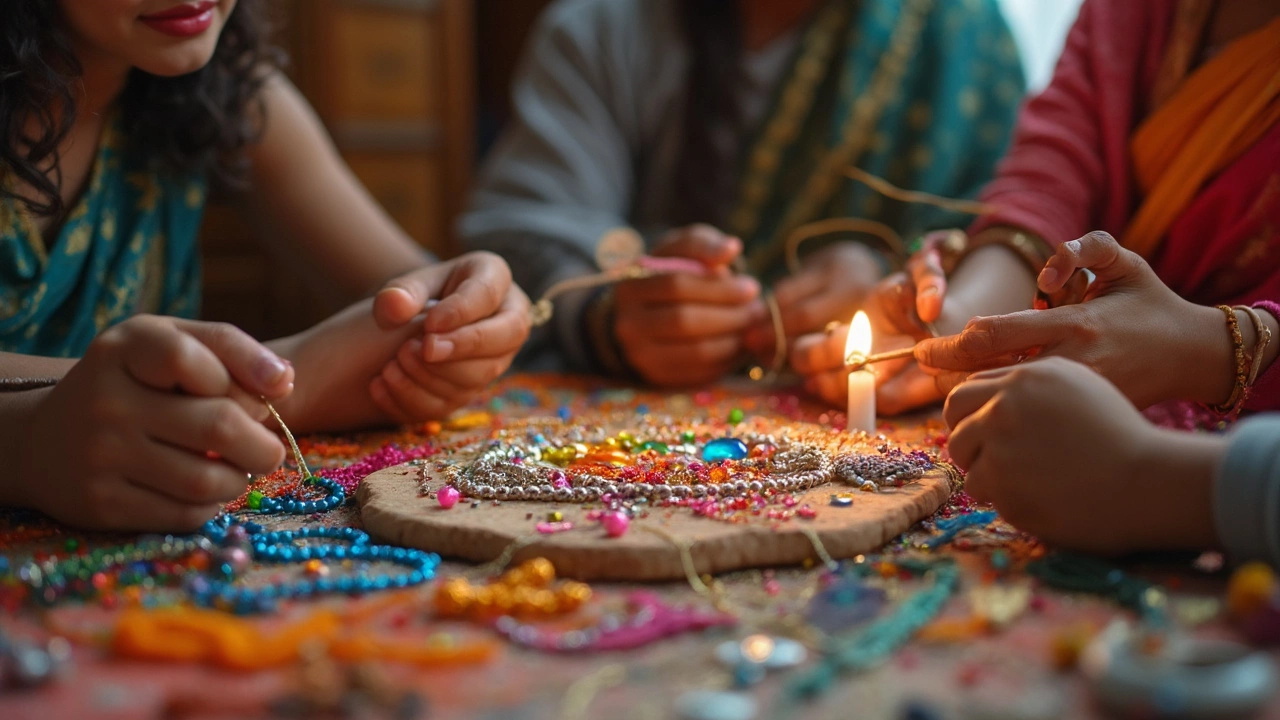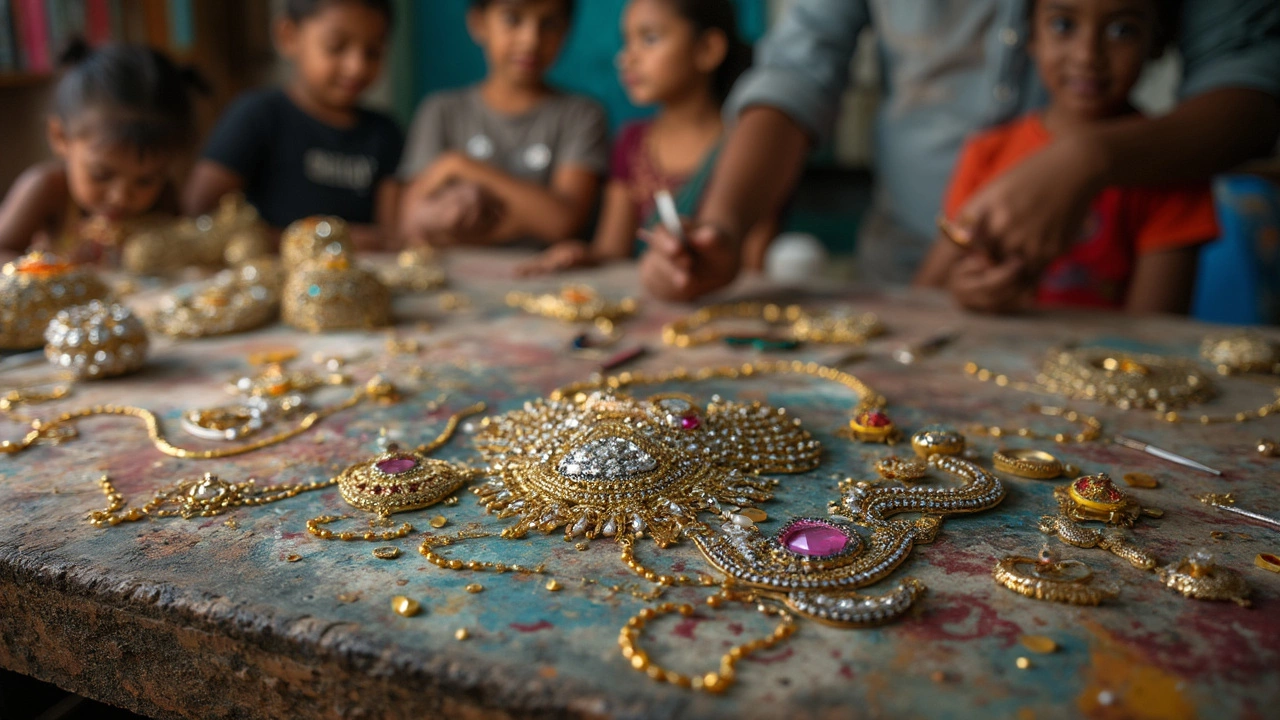
Ever stared at a pile of beads, wires, and tiny pliers and wondered, 'Could I really make something good out of this?' The answer: absolutely. In fact, a lot of the so-called 'best jewellery makers' got their start messing around with simple kits at home. It's not about fancy tools or rare gems—it boils down to the kit you pick and how much you play around with it.
Most people think you need professional skills or expensive equipment to make great jewellery, but that's just not true anymore. These days, kits do a lot of the hard work: they give you clear instructions, the right materials, and even some playful inspiration. Whether you're into beaded bracelets, wire-wrapped rings, or quirky earrings with charms, there's a kit out there that doesn't just make it easy—it makes it fun. You'd be surprised how fast you can turn a first try into something you'd actually wear (or, let's be real, proudly gift to your mom).
- What Makes a Jewellery Maker the Best?
- Breaking Down Top Jewellery Making Kits
- Tips for Picking the Right Kit for You
- Level Up: From Kits to Custom Creations
What Makes a Jewellery Maker the Best?
There's a common belief that a jewellery maker is only as good as their hands. But real talk? It's a mix of skill, creativity, and the right jewellery making kits. Most standout creators started with kits before ever moving on to fancy tools or pricey materials. So what actually sets the best apart?
Consistency is a major factor. The best jewellery makers can whip up clean, strong pieces every time, whether they're making DIY earrings or a complex layered necklace. Technique matters. Anyone can thread a bead or twist some wire, but details like neat crimps, well-hidden knots, and sturdy clasps are what give finished pieces that wow factor. Even basic kits will show you how to do these steps right from the start.
Another thing all top jewellery makers have in common: a willingness to experiment. They mix colors, try weird combinations, and don’t panic if something doesn’t work out. Some of the biggest design trends—like charm stacking and mismatched pairs—actually took off because someone tried something a little odd and stuck with it. So the best kit isn’t just one that gives you instructions; it’s one that inspires you to mess around and try your own ideas.
Don’t forget about creativity and personal style. The most memorable pieces often come when someone throws out the rulebook. The best kits help with that—they include plenty of variety so you aren’t just making the same bracelet as everyone else. Look for kits that offer tons of beads, colors, and findings, not just ten of the same thing.
If you’re serious about comparing skill levels, here’s a quick breakdown:
| Jewellery Maker Type | Skill Focus | Common Tools/Kits |
|---|---|---|
| Beginner | Basic stringing, knotting | Bead kits, elastic cord sets |
| Intermediate | Wire-wrapping, simple metalwork | Wire kits, pliers, charms |
| Advanced | Soldering, custom designs | Specialty kits, metal stamping tools |
Here’s the deal: the "best" jewellery maker isn’t someone with a crazy degree or a background in art. It’s usually the one who mixes skill, reliable gear, and a bit of playful risk-taking. And a good jewellery making kit? That’s your ticket in, no matter where you start.
Breaking Down Top Jewellery Making Kits
Shopping for jewellery making kits can feel overwhelming at first. There are a ton of options online, with prices ranging from under $15 to over $100. But how do you know which kits are actually worth your time and money? Here’s what separates the good ones from the duds.
Start with what’s inside the box. A strong kit should have real basics: pliers, cutters, a beading mat, plus wires, clasps, and beads that aren’t made of flimsy plastic. Lots of kits advertised for beginners actually skip the decent tools, making it hard to build on your skills later. Popular picks like the PandaHall Starter Kit or the Paxcoo Jewelry Making Supplies Kit tend to stand out because they offer a chunky set of tools, various findings (like jump rings and lobster clasps), and a generous supply of beads—usually over 1,000 pieces per kit. Those numbers are no joke for folks who want to experiment without running out mid-project.
For kids or total beginners, look for kits that put an extra focus on safety and include super clear step-by-step guides. Melissa & Doug makes bead kits that are kid-friendly and skip small, swallowable parts. On the other hand, brands like Gemybeads or Beadalon throw in more advanced components for teens and adults eager to try wire-wrapping or crimping. They usually include illustrated instructions, but video tutorials are even better. Beadalon, for example, links to full online lessons right from the box.
Here’s a quick snapshot of what the top sellers offer:
| Kit Name | Best For | # of Beads/Findings | Key Tools Included | Age Range |
|---|---|---|---|---|
| PandaHall Starter Kit | Teens/Adults | 1200+ | Pliers, tweezers, wire | 14+ |
| Paxcoo Jewelry Making | Beginner to Advanced | 1500+ | 3 pliers, jump rings, wire | 15+ |
| Melissa & Doug Bead Kit | Kids | 100-200 | Wooden beads, cords | 4-8 |
| Gemybeads Deluxe | Teens/Adults | 1000+ | Pliers, wires, bead board | 13+ |
If you’re a sucker for clever storage, check reviews. PandaHall gets high marks for neat, divided boxes—no digging through a mess when you want one little earring hook. Just as important, consider the materials. Glass and metal beads hold up better than plastic, especially for jewellery you’ll wear often.
The truth is, the best jewellery maker isn’t just about one famous brand. It’s about finding a kit that gives you room to learn, mess up, and make something cool—no fancy studio required.

Tips for Picking the Right Kit for You
Picking the right jewellery making kit is a lot easier once you know what you're looking for. There’s no one-size-fits-all option, especially with so many choices out there. Start by asking yourself: ‘What do I actually want to make?’ If you’re just starting, those all-in-one kits with everything you need — tools, beads, instructions — really help. Kits like the well-reviewed PandaHall or Gemybeads bead sets don’t just come with a ton of materials but also detailed guides with pictures, which are a lifesaver for beginners.
Another big thing: age matters. If you're buying for kids, look for kits labeled ages 7+ that use safer materials and have fewer tiny pieces. Brands like Melissa & Doug are known for sturdy, kid-friendly kits, while adults might want something with more variety like PotomacBeads or ImpressArt for stamping metal jewelry.
Think about the type of jewellery too. Some DIY jewellery kits focus just on bracelets, while others cover everything from rings to multi-layered necklaces. When in doubt, a kit with more components lets you try out different stuff before you settle on your favorite.
Budget counts as well. High-end craft kits can go up to $50 or more, but there are plenty of solid options in the $15-$25 range that don’t feel cheap. And if you spot a kit with a video tutorial or a big online community (like Beadaholique or Fire Mountain Gems sets), that’s always a plus—help is there if you get stuck.
- Check the kit’s material list. Cheaper plastic beads can look tacky in finished pieces, so look for kits with glass, crystal, or metal parts.
- Read reviews before buying. Real user photos can give you a better idea of what you’ll actually make.
- Consider storage. Some kits come with reusable compartment boxes, which save you so much hassle later.
Just for some perspective, here’s a quick breakdown of what people look for most before buying a jewellery making kit:
| Feature | % of Buyers Prioritizing |
|---|---|
| Material Quality | 42% |
| Clear Instructions | 33% |
| Tool Variety | 19% |
| Storage Box | 6% |
Bottom line: make sure your kit matches your skill level and what you actually want to make. If you get this bit right, you’ll actually finish your projects—maybe even start wearing them out in public.
Level Up: From Kits to Custom Creations
Once you’ve tackled a few jewellery making kits, you’ll probably start itching to do your own thing. Kits are awesome for learning the basics—their instructions spell out every step, and you don’t have to hunt down every tiny bead. But when you’re ready to make something that’s totally yours, breaking out of the kits can be way more fun.
The good news? All those kit skills pay off. You already know how to crimp a bead, twist wire, or attach clasps. Now, you can swap out materials—grab fancier beads online, play with sterling silver wire, mix in stones with cool textures, or even try resin or clay. Suddenly, you’re creating pieces that look nothing like whatever came in the original box.
When people go beyond kits, most start with these steps:
- Design your own layout – Sketch ideas, or just lay out beads in a new pattern. No need to be an artist. Take a pic with your phone before you string them up so you don’t forget the pattern.
- Mix and match supplies – Visit local bead shops or browse online stores. Sites like Etsy and Fire Mountain Gems have way more variety than most kits, from Czech glass to natural gemstones.
- Upgrade your tools – Every pro will tell you: a decent set of pliers and flush cutters makes a huge difference. Kits come with basics, but a $10 upgrade can save you serious frustration.
- Customize for size and color – Instead of following kit sizing, measure your own wrist, or use a color combo that actually matches your style.
If you get stuck, YouTube is packed with tutorials from self-taught makers. A lot of hobbyists become small business owners: in 2024, over 20,000 shops sold handmade jewellery on Etsy. This isn’t just a hobby—it’s a legit side hustle for tons of people.
Here’s a quick comparison for what you get with a kit versus what you unlock when you go DIY:
| With a Kit | Going Custom |
|---|---|
| Step-by-step instructions | Room to experiment and freestyle |
| Limited materials and designs | Your pick of materials, colors, and shapes |
| Mostly basic tools | Ability to invest in pro-quality tools |
| Cookie-cutter results | One-of-a-kind pieces |
That’s how people go from snapping together kit bracelets to making custom DIY jewellery that gets noticed. Don’t be afraid to ditch the pre-made instructions and try something new. Every pro started out nervous—what matters most is just starting.


